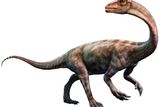Science
Ancient Dinosaur Fossil Discovered in Argentina’s La Rioja

In a significant paleontological find, researchers in Argentina have unearthed a fossil belonging to one of the world’s oldest dinosaurs, dating back approximately 230 million years. The discovery, made in the foothills of the Sierra de Velasco mountain range in La Rioja, introduces a new long-necked species named Huayracursor jaguensis, despite the specimen being notably headless.
The findings, detailed in the journal Nature, reveal an almost complete skeleton, which includes parts of the skull, vertebral column, forelimbs, and hindlimbs. According to Agustín Martinelli, a researcher at the Bernardino Rivadavia Argentine Museum of Natural Sciences, this discovery positions Huayracursor as a crucial part of the evolutionary timeline of dinosaurs.
Uncovering a New Species
Huayracursor is classified as an early sauropodomorph, a group of herbivorous dinosaurs recognized for their distinctive long necks. Measuring around 2 meters (approximately 6 feet) in length and weighing roughly 18 kilograms (about 40 pounds), this dinosaur was larger than its contemporaries, such as the Bagualasaurus. The size of Huayracursor is significant, as it represents an early evolutionary step in the lineage of its family.
Martín Hechenleitner, a researcher at CONICET, noted that the dinosaur exhibits two defining features: a notably elongated neck and a size larger than most of its contemporaries. He emphasized that these characteristics reflect an early development of traits fundamental to the evolutionary history of the sauropodomorphs.
Exploration of Uncharted Territory
The discovery was made by a pioneering team of scientists who ventured into a previously unexplored region of La Rioja province. Prior to this expedition, the area had remained largely unexamined due to its challenging terrain and harsh weather conditions. Over the past decade, paleontologists have uncovered a wealth of Triassic fauna in this region, marking it as a rich site for future discoveries.
Martinelli expressed enthusiasm about the potential for further exploration in this virtually untouched geological basin. “It’s rare to discover entirely new sites with fauna that is extraordinarily preserved and abundant,” he remarked.
The name Huayracursor reflects its environment, with “Huayra” referring to the strong winds typical of the area and “jaguensis” honoring the nearby village of Jagué, where the fossil was found. As researchers continue to study this remarkable specimen, it promises to enhance our understanding of early dinosaur evolution.
The completeness of the fossil presents an exciting opportunity for scientists to broaden the knowledge surrounding the early evolution of sauropodomorphs. Looking ahead, the research team plans to extend their expeditions further into the Andes, potentially uncovering more ancient life forms.
Sebastián Rocher, another author of the study, indicated that ongoing stratigraphic and sedimentological research has revealed that the Triassic formations in the Northern Precordillera represent a sedimentary basin that evolved independently from others in southwestern Gondwana. This insight opens new avenues for exploration and discovery in the region.
The unearthing of Huayracursor jaguensis not only adds a significant chapter to the history of dinosaurs but also underscores the importance of continued exploration in paleontology. As scientists delve deeper into these ancient landscapes, each discovery contributes to the larger narrative of life on Earth during the Triassic period.
-

 Science1 week ago
Science1 week agoResearchers Challenge 200-Year-Old Physics Principle with Atomic Engines
-

 Politics1 week ago
Politics1 week agoNHP Foundation Secures Land for 158 Affordable Apartments in Denver
-

 Health1 week ago
Health1 week agoNeuroscientist Advocates for Flag Football Until Age 14
-

 Health1 week ago
Health1 week agoFDA Launches Fast-Track Review for Nine Innovative Therapies
-

 Lifestyle1 week ago
Lifestyle1 week agoLongtime Friends Face Heartbreak After Loss and Isolation
-

 Business1 week ago
Business1 week agoMaine Housing Inventory Surges to Post-Pandemic High
-

 Politics1 week ago
Politics1 week agoIsraeli Air Strikes in Lebanon Kill One, Wound Seven Amid Tensions
-

 World1 week ago
World1 week agoTroops to Enjoy Buffalo Chicken, Thai Curry in 2026 MREs
-

 Top Stories1 week ago
Top Stories1 week agoUnforgettable Moments: The Best Victoria’s Secret Performances
-

 World1 week ago
World1 week agoGlobal Military Spending: Air Forces Ranked by Budget and Capability
-

 Politics1 week ago
Politics1 week agoMassachusetts Lawmakers Resist Audit After Voter Mandate
-

 Business1 week ago
Business1 week agoSpirit Airlines Cuts Workforce with Furloughs for 365 Pilots









